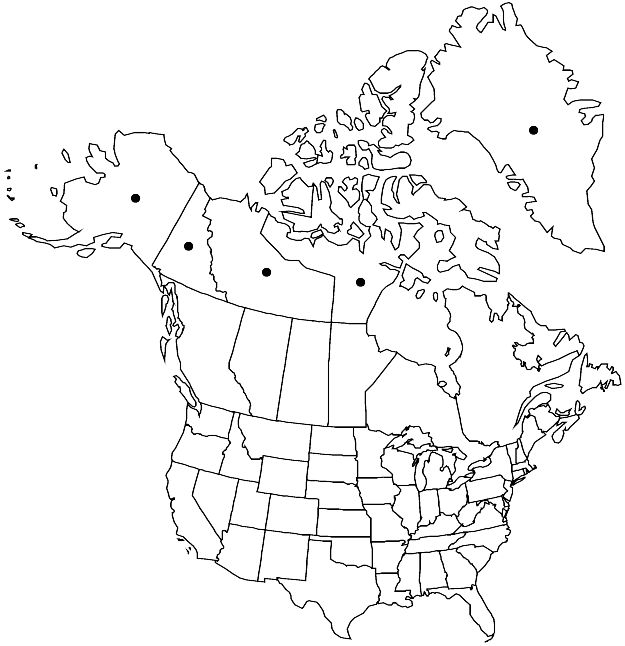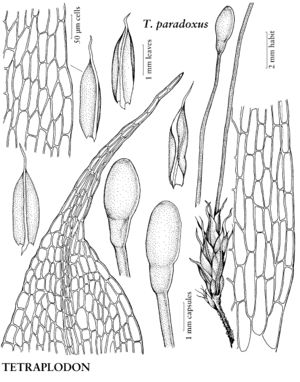Difference between revisions of "Tetraplodon paradoxus"
Nyt Mag. Naturvidensk. 38: 332. 1901.
FNA>Volume Importer |
imported>Volume Importer |
||
| (6 intermediate revisions by 2 users not shown) | |||
| Line 9: | Line 9: | ||
|special_status={{Treatment/ID/Special_status | |special_status={{Treatment/ID/Special_status | ||
|code=F | |code=F | ||
| − | |label= | + | |label=Illustrated |
}} | }} | ||
| − | |basionyms={{Treatment/ID/ | + | |basionyms={{Treatment/ID/Basionym |
|name=Splachnum paradoxum | |name=Splachnum paradoxum | ||
|authority=R. Brown | |authority=R. Brown | ||
| + | |rank=species | ||
| + | |publication_title=Chlor. Melvill., | ||
| + | |publication_place=44. 1823 | ||
}} | }} | ||
|synonyms={{Treatment/ID/Synonym | |synonyms={{Treatment/ID/Synonym | ||
|name=Tetraplodon mnioides var. paradoxus | |name=Tetraplodon mnioides var. paradoxus | ||
|authority=(R. Brown) Jensen | |authority=(R. Brown) Jensen | ||
| + | |rank=variety | ||
}} | }} | ||
|hierarchy=Splachnaceae;Tetraplodon;Tetraplodon paradoxus | |hierarchy=Splachnaceae;Tetraplodon;Tetraplodon paradoxus | ||
| Line 33: | Line 37: | ||
|elevation=moderate to high elevations | |elevation=moderate to high elevations | ||
|distribution=Greenland;N.W.T.;Nunavut;Yukon;Alaska;n Europe (Arctic Russia). | |distribution=Greenland;N.W.T.;Nunavut;Yukon;Alaska;n Europe (Arctic Russia). | ||
| − | |discussion=<p>Tetraplodon paradoxus is much confused in the literature with T. pallidus (W. C. Steere 1977), although the two are easily distinguished. Tetraplodon paradoxus is cleistocarpous, the setae are longer (to twice as long), leaves smaller and more narrow, and capsules are darker and spindle- or club-shaped, with the hypophysis noticeably narrower than the urn and having fewer stomata. Steere suggested that spore dispersal to fresh dung might occur when the sporophytes are ingested by caribou or muskoxen and the spores subsequently dropped in dung at some other location.</p> | + | |discussion=<p><i>Tetraplodon paradoxus</i> is much confused in the literature with <i>T. pallidus</i> (W. C. Steere 1977), although the two are easily distinguished. <i>Tetraplodon paradoxus</i> is cleistocarpous, the setae are longer (to twice as long), leaves smaller and more narrow, and capsules are darker and spindle- or club-shaped, with the hypophysis noticeably narrower than the urn and having fewer stomata. Steere suggested that spore dispersal to fresh dung might occur when the sporophytes are ingested by caribou or muskoxen and the spores subsequently dropped in dung at some other location.</p> |
|tables= | |tables= | ||
|references= | |references= | ||
| Line 42: | Line 46: | ||
-->{{#Taxon: | -->{{#Taxon: | ||
name=Tetraplodon paradoxus | name=Tetraplodon paradoxus | ||
| − | |||
|authority=(R. Brown) I. Hagen | |authority=(R. Brown) I. Hagen | ||
|rank=species | |rank=species | ||
| Line 56: | Line 59: | ||
|publication title=Nyt Mag. Naturvidensk. | |publication title=Nyt Mag. Naturvidensk. | ||
|publication year=1901 | |publication year=1901 | ||
| − | |special status= | + | |special status=Illustrated |
| − | |source xml=https:// | + | |source xml=https://bitbucket.org/aafc-mbb/fna-data-curation/src/2e0870ddd59836b60bcf96646a41e87ea5a5943a/coarse_grained_fna_xml/V28/V28_13.xml |
|genus=Tetraplodon | |genus=Tetraplodon | ||
|species=Tetraplodon paradoxus | |species=Tetraplodon paradoxus | ||
Latest revision as of 21:34, 5 November 2020
Plants 2–4 cm, light green or yellow-green. Leaves ovate, concave, 2–5 mm; margins entire or nearly so; apex acuminate; costa ending in subula; distal laminal cells hexagonal, 30 µm. Sexual condition autoicous. Seta clear pale yellow to stramineous, 2–3.5 cm. Capsule cleistocarpous, clear pale yellow to stramineous, spindle- or club-shaped; hypophysis conspicuously narrower than urn; stomata confined to distal hypophysis; operculum not developed. Calyptra cucullate or conic-mitrate. Spores 9 µm, smooth.
Phenology: Capsules mature summer.
Habitat: Caribou or muskox dung
Elevation: moderate to high elevations
Distribution

Greenland, N.W.T., Nunavut, Yukon, Alaska, n Europe (Arctic Russia).
Discussion
Tetraplodon paradoxus is much confused in the literature with T. pallidus (W. C. Steere 1977), although the two are easily distinguished. Tetraplodon paradoxus is cleistocarpous, the setae are longer (to twice as long), leaves smaller and more narrow, and capsules are darker and spindle- or club-shaped, with the hypophysis noticeably narrower than the urn and having fewer stomata. Steere suggested that spore dispersal to fresh dung might occur when the sporophytes are ingested by caribou or muskoxen and the spores subsequently dropped in dung at some other location.
Selected References
None.
